By Alex Trukan
Pressing is a defending strategy based on applying pressure on the ball and restricting spaces around and away from the ball in order to regain possession. It is often associated with teams defending with intensity and desire to win the ball as high and as soon as possible. However, it is important to understand that high pressing is only a small part of defending phase which can incorporate various different strategies such as medium pressing, counter-pressing, defending deep or defending around the penalty box. Pressing is therefore a link in sequence of defending phase starting from the moment of losing the ball until it is regained back. This will be presented using FC Porto team in a friendly against Borussia Monchengladbach.
Moment of losing the ball
Straight after the team lost the ball, it is important to try and take advantage of the opponents offensive disorganisation (close distances to each other, lack of attacking structure) by applying immediate pressure on the ball as well as cutting nearest passing options (access oriented pressing). First priority would be to regain possession and attack, whereas the biggest danger is a long pass to the strikers. Therefore, the role of the players away from the ball would be to anticipate danger and similarly to the players around the ball, narrow up and get compact. If it is impossible to regain possession, the opposition should be forced back and access to the key players should be denied.
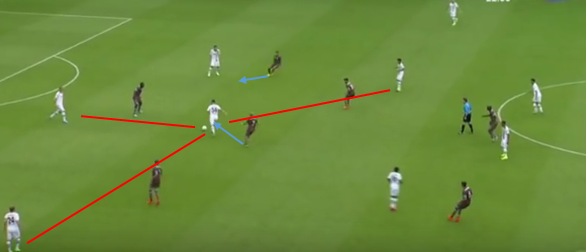
If the ball is passed back to the goalkeeper, one of the pressing players (nearest to the ball) should follow and apply pressure on the goalkeeper what would affect the ball flight and stop the goalkeeper making an accurate forward pass. Rest of the team should squeeze up and deny spaces on the opposition half.
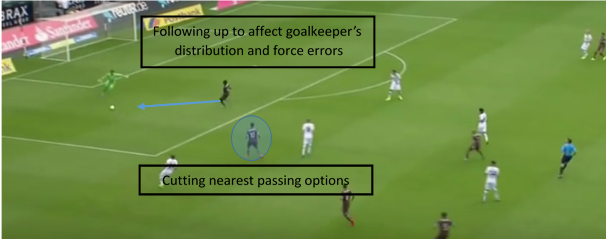
Getting organised
If the opposition plays through or away from initial pressing, the team should get organised behind the ball as any further press will be likely ineffective. That might be triggered by time i.e.5 seconds to regain possession and then retreat to get organised or by particular play by the opposition i.e.switch to the other side. When the opposition back line is in possession, that will usually mean all the players behind the ball in a compact block. Retreating behind the ball doesn’t mean that the team stops to press tough. Getting organised gives additional time as well as helps players to build defensive connections to then apply medium press more effectively.
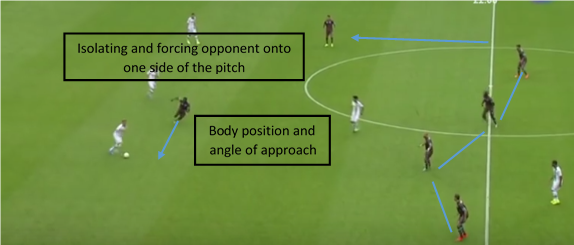
As the ball is played across the back line, the defending team waits for the right trigger to press the ball more aggresively. It is important not to over commit the press when it’s not the right time do it as the opposition will have the opportunity to exploit the weaknesses. The defending team should stay together, move together and arrive together maintaing their small distances to each other and shape.
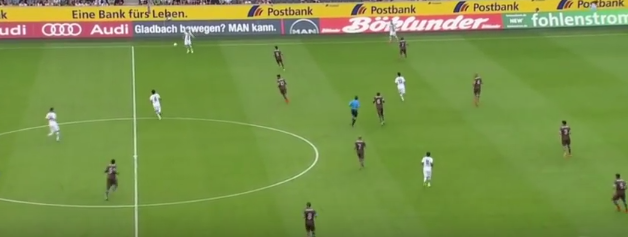
Defensive connections is a crucial aspect of winning the ball effectively. It can be described as an ability of the players around the ball to pressurise and provide immediate support for the player who pressurises in case he gets beaten. That gives the team a strong platform to apply pressing as a unit.
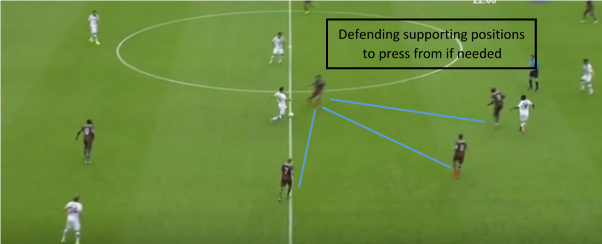
Pressing off triggers
When defending in an organised shape, it is important to recognise the right moment to apply more intensive pressing higher up the pitch forcing the opposition to give the ball away or lose space by passing back. There are various triggers that can be applied depending on the tactics and opposition characteristics i.e. pass to the full back, bad touch, slow pass, pass to a certain player etc. When the trigger starts the action, the team should be confident in the application of the press and work together as a compact unit.
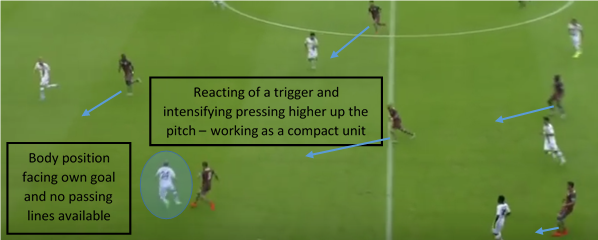
There is no effective team that presses high up the pitch at all times when out of possession. Effective defending is based on recognising when to press high and when to drop to get organised and prepare to press again. Some teams may prefer one startegy or the other, and be better in one particular way of defending, but at some point in the game, the best solution might be the less trained option. Therefore, effective teams out of possession should be ready to apply and understand the whole defending ‘sequence’ starting from losing the ball up until winning it again.
By Alex Trukan, Development Coach, Nottingham Forest
@AlexTrukan


